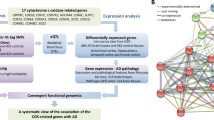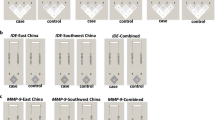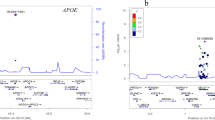Abstract
Alzheimer’s disease (AD) is the most common form of dementia. The deposition of β-amyloid (Aβ) plaques in the brain was considered one of the main neuropathological hallmarks of AD. As the loss of synapses always occurs during AD progression, AD has been gradually regarded as a “synaptopathy.” The activity-regulated cytoskeleton-associated protein (Arc) was recently identified as a key factor for AD due to its active roles in synaptic plasticity, learning, memory, and Aβ generation. However, there is little evidence to support the association of the Arc gene with AD. In this study, a two-stage case-control study of 1471 Han Chinese was conducted to investigate the genetic association between the Arc gene and AD. Variant rs10097505 in the 3′UTR region was significantly associated with AD. The whole exons of the Arc gene were also screened in 99 AD patients with a high heritability (familial and/or onset age <55 years old). One missense variant (c.20G>A, p.T7I) was identified in two AD patients but was absent in the controls from the general populations. Both rs10097505 and c.20G>A were predicted to be potentially pathogenic. Further luciferase assay, data mining, and integrative analyses revealed that the AD-risk genotype AA of rs10097505 was associated with an increased Arc mRNA expression and an elevated Aβ level. Our results indicated that the Arc gene would confer susceptibility to AD in Han Chinese, probably through changing the protein structure or affecting the Arc expression in brain tissues, which would finally contribute to the pathogenesis and development of AD.




Similar content being viewed by others
References
Querfurth HW, LaFerla FM (2010) Alzheimer’s disease. N Engl J Med 362(4):329–344
Hardy JA, Higgins GA (1992) Alzheimer’s disease: the amyloid cascade hypothesis. Science 256(5054):184–185
Hardy J, Selkoe DJ (2002) The amyloid hypothesis of Alzheimer’s disease: progress and problems on the road to therapeutics. Science 297(5580):353–356
Bertram L, Lill CM, Tanzi RE (2010) The genetics of Alzheimer disease: back to the future. Neuron 68(2):270–281
Karch CM, Goate AM (2015) Alzheimer’s disease risk genes and mechanisms of disease pathogenesis. Biol Psychiatry 77(1):43–51
De Strooper B, Karran E (2016) The cellular phase of Alzheimer’s disease. Cell 164(4):603–615
Sevigny J, Chiao P, Bussiere T, Weinreb PH, Williams L, Maier M et al (2016) The antibody aducanumab reduces Abeta plaques in Alzheimer’s disease. Nature 537(7618):50–56
Kerrigan TL, Randall AD (2013) A new player in the “synaptopathy” of Alzheimer’s disease-arc/arg 3.1. Front Neurol 4:9
Bramham CR, Worley PF, Moore MJ, Guzowski JF (2008) The immediate early gene arc/arg3.1: regulation, mechanisms, and function. J Neurosci 28(46):11760–11767
Lyford GL, Yamagata K, Kaufmann WE, Barnes CA, Sanders LK, Copeland NG et al (1995) Arc, a growth factor and activity-regulated gene, encodes a novel cytoskeleton-associated protein that is enriched in neuronal dendrites. Neuron 14(2):433–445
Ying SW, Futter M, Rosenblum K, Webber MJ, Hunt SP, Bliss TV et al (2002) Brain-derived neurotrophic factor induces long-term potentiation in intact adult hippocampus: requirement for ERK activation coupled to CREB and upregulation of arc synthesis. J Neurosci 22(5):1532–1540
Plath N, Ohana O, Dammermann B, Errington ML, Schmitz D, Gross C et al (2006) Arc/Arg3.1 is essential for the consolidation of synaptic plasticity and memories. Neuron 52(3):437–444
Waung MW, Pfeiffer BE, Nosyreva ED, Ronesi JA, Huber KM (2008) Rapid translation of arc/Arg3.1 selectively mediates mGluR-dependent LTD through persistent increases in AMPAR endocytosis rate. Neuron 59(1):84–97
Bramham CR, Alme MN, Bittins M, Kuipers SD, Nair RR, Pai B et al (2010) The Arc of synaptic memory. Exp Brain Res 200(2):125–140
Guzowski JF, Lyford GL, Stevenson GD, Houston FP, McGaugh JL, Worley PF et al (2000) Inhibition of activity-dependent arc protein expression in the rat hippocampus impairs the maintenance of long-term potentiation and the consolidation of long-term memory. J Neurosci 20(11):3993–4001
Lacor PN, Buniel MC, Chang L, Fernandez SJ, Gong Y, Viola KL et al (2004) Synaptic targeting by Alzheimer’s-related amyloid beta oligomers. J Neurosci 24(45):10191–10200
Wu J, Petralia RS, Kurushima H, Patel H, Jung MY, Volk L et al (2011) Arc/Arg3.1 regulates an endosomal pathway essential for activity-dependent beta-amyloid generation. Cell 147(3):615–628
Landgren S, von Otter M, Palmer MS, Zetterstrom C, Nilsson S, Skoog I et al (2012) A novel ARC gene polymorphism is associated with reduced risk of Alzheimer’s disease. J Neural Transm (Vienna) 119(7):833–842
Bi R, Zhao L, Zhang C, Lu W, Feng JQ, Wang Y et al (2014) No association of the LRRK2 genetic variants with Alzheimer’s disease in Han Chinese individuals. Neurobiol Aging 35(2):444. e5–9
Wang HZ, Bi R, Hu QX, Xiang Q, Zhang C, Zhang DF et al (2016) Validating GWAS-identified risk loci for Alzheimer’s disease in Han Chinese populations. Mol Neurobiol 53(1):379–390
Wang HZ, Bi R, Zhang DF, Li GD, Ma XH, Fang Y et al (2016) Neprilysin confers genetic susceptibility to Alzheimer’s disease in Han Chinese. Mol Neurobiol 53(7):4883–4892
Zhang DF, Li J, Wu H, Cui Y, Bi R, Zhou HJ et al (2016) CFH variants affect structural and functional brain changes and genetic risk of Alzheimer’s disease. Neuropsychopharmacology 41(4):1034–1045
McKhann G, Drachman D, Folstein M, Katzman R, Price D, Stadlan EM (1984) Clinical diagnosis of Alzheimer’s disease: report of the NINCDS-ADRDA work group under the auspices of Department of Health and Human Services Task Force on Alzheimer’s disease. Neurology 34(7):939–944
Barrett JC, Fry B, Maller J, Daly MJ (2005) Haploview: analysis and visualization of LD and haplotype maps. Bioinformatics 21(2):263–265
International HapMap Consortium (2003) The International HapMap Project. Nature 426(6968):789–796
Zhang DF, Fan Y, Wang D, Bi R, Zhang C, Fang Y et al (2015) PLD3 in Alzheimer’s disease: a modest effect as revealed by updated association and expression analyses. Mol Neurobiol 53(6):4034–4045
Wang D, Li GD, Zhang DF, Xu L, Li XA, Yu XF et al (2016) Genetic variants of the MAVS, MITA and MFN2 genes are not associated with leprosy in Han Chinese from Southwest China. Infect Genet Evol 45:105–110
Li H, Durbin R (2009) Fast and accurate short read alignment with Burrows-Wheeler transform. Bioinformatics 25(14):1754–1760
Li H (2011) A statistical framework for SNP calling, mutation discovery, association mapping and population genetical parameter estimation from sequencing data. Bioinformatics 27(21):2987–2993
Li H, Handsaker B, Wysoker A, Fennell T, Ruan J, Homer N et al (2009) The sequence alignment/map format and SAMtools. Bioinformatics 25(16):2078–2079
DePristo MA, Banks E, Poplin R, Garimella KV, Maguire JR, Hartl C et al (2011) A framework for variation discovery and genotyping using next-generation DNA sequencing data. Nat Genet 43(5):491–498
Auton A, Brooks LD, Durbin RM, Garrison EP, Kang HM, Korbel JO et al (2015) A global reference for human genetic variation. Nature 526(7571):68–74
Abecasis GR, Auton A, Brooks LD, DePristo MA, Durbin RM, Handsaker RE et al (2012) An integrated map of genetic variation from 1,092 human genomes. Nature 491(7422):56–65
Lek M, Karczewski KJ, Minikel EV, Samocha KE, Banks E, Fennell T et al (2016) Analysis of protein-coding genetic variation in 60,706 humans. Nature 536(7616):285–291
Kircher M, Witten DM, Jain P, O’Roak BJ, Cooper GM, Shendure J (2014) A general framework for estimating the relative pathogenicity of human genetic variants. Nat Genet 46(3):310–315
Ramasamy A, Trabzuni D, Guelfi S, Varghese V, Smith C, Walker R et al (2014) Genetic variability in the regulation of gene expression in ten regions of the human brain. Nat Neurosci 17(10):1418–1428
Kallberg M, Wang H, Wang S, Peng J, Wang Z, Lu H et al (2012) Template-based protein structure modeling using the RaptorX web server. Nat Protoc 7(8):1511–1522
Gauderman WJ (2002) Sample size requirements for matched case-control studies of gene-environment interaction. Stat Med 21(1):35–50
Purcell S, Neale B, Todd-Brown K, Thomas L, Ferreira MA, Bender D et al (2007) PLINK: a tool set for whole-genome association and population-based linkage analyses. Am J Hum Genet 81(3):559–575
Simpson JE, Ince PG, Shaw PJ, Heath PR, Raman R, Garwood CJ et al (2011) Microarray analysis of the astrocyte transcriptome in the aging brain: relationship to Alzheimer’s pathology and APOE genotype. Neurobiol Aging 32(10):1795–1807
Durrenberger PF, Fernando FS, Magliozzi R, Kashefi SN, Bonnert TP, Ferrer I et al (2012) Selection of novel reference genes for use in the human central nervous system: a BrainNet Europe study. Acta Neuropathol 124(6):893–903
Berson A, Barbash S, Shaltiel G, Goll Y, Hanin G, Greenberg DS et al (2012) Cholinergic-associated loss of hnRNP-A/B in Alzheimer’s disease impairs cortical splicing and cognitive function in mice. EMBO Mol Med 4(8):730–742
Berchtold NC, Cribbs DH, Coleman PD, Rogers J, Head E, Kim R et al (2008) Gene expression changes in the course of normal brain aging are sexually dimorphic. Proc Natl Acad Sci U S A 105(40):15605–15610
Liang WS, Dunckley T, Beach TG, Grover A, Mastroeni D, Walker DG et al (2007) Gene expression profiles in anatomically and functionally distinct regions of the normal aged human brain. Physiol Genomics 28(3):311–322
Taminau J, Meganck S, Lazar C, Steenhoff D, Coletta A, Molter C et al (2012) Unlocking the potential of publicly available microarray data using inSilicoDb and inSilicoMerging R/Bioconductor packages. BMC Bioinformatics 13:335
Weiner MW, Aisen PS, Jack CR Jr, Jagust WJ, Trojanowski JQ, Shaw L et al (2010) The Alzheimer’s disease neuroimaging initiative: progress report and future plans. Alzheimers Dement 6(3):202–211. e7
Yao YG, Kong QP, Bandelt HJ, Kivisild T, Zhang YP (2002) Phylogeographic differentiation of mitochondrial DNA in Han Chinese. Am J Hum Genet 70(3):635–651
Shepherd JD, Bear MF (2011) New views of Arc, a master regulator of synaptic plasticity. Nat Neurosci 14(3):279–284
Fromer M, Pocklington AJ, Kavanagh DH, Williams HJ, Dwyer S, Gormley P et al (2014) De novo mutations in schizophrenia implicate synaptic networks. Nature 506(7487):179–184
Purcell SM, Moran JL, Fromer M, Ruderfer D, Solovieff N, Roussos P et al (2014) A polygenic burden of rare disruptive mutations in schizophrenia. Nature 506(7487):185–190
Elizalde N, Pastor PM, Garcia-Garcia AL, Serres F, Venzala E, Huarte J et al (2010) Regulation of markers of synaptic function in mouse models of depression: chronic mild stress and decreased expression of VGLUT1. J Neurochem 114(5):1302–1314
Myrum C, Giddaluru S, Jacobsen K, Espeseth T, Nyberg L, Lundervold AJ et al (2015) Common variants in the ARC gene are not associated with cognitive abilities. Brain Behav 5(10):e00376
Lambert JC, Ibrahim-Verbaas CA, Harold D, Naj AC, Sims R, Bellenguez C et al (2013) Meta-analysis of 74,046 individuals identifies 11 new susceptibility loci for Alzheimer’s disease. Nat Genet 45(12):1452–1458
Wegenast-Braun BM, Fulgencio Maisch A, Eicke D, Radde R, Herzig MC, Staufenbiel M et al (2009) Independent effects of intra- and extracellular Abeta on learning-related gene expression. Am J Pathol 175(1):271–282
Alhowikan AM (2016) Activity-regulated cytoskeleton-associated protein dysfunction may contribute to memory disorder and earlier detection of autism spectrum disorders. Med Princ Pract 25(4):350–354
Shepherd JD, Rumbaugh G, Wu J, Chowdhury S, Plath N, Kuhl D et al (2006) Arc/Arg3.1 mediates homeostatic synaptic scaling of AMPA receptors. Neuron 52(3):475–484
Hansson O, Zetterberg H, Buchhave P, Londos E, Blennow K, Minthon L (2006) Association between CSF biomarkers and incipient Alzheimer’s disease in patients with mild cognitive impairment: a follow-up study. Lancet Neurol 5(3):228–234
Shaw LM, Vanderstichele H, Knapik-Czajka M, Clark CM, Aisen PS, Petersen RC et al (2009) Cerebrospinal fluid biomarker signature in Alzheimer’s disease neuroimaging initiative subjects. Ann Neurol 65(4):403–413
Blennow K, Dubois B, Fagan AM, Lewczuk P, de Leon MJ, Hampel H (2015) Clinical utility of cerebrospinal fluid biomarkers in the diagnosis of early Alzheimer’s disease. Alzheimers Dement 11(1):58–69
Acknowledgements
We thank all participants in this study. We thank Miss Hui-Zhen Wang and Qiu-Xiang Hu for technical assistance and Dr. Jirong Long for searching the Arc variant p.T7I in her unpublished dataset. This study was supported by the Strategic Priority Research Program (B) of the Chinese Academy of Sciences (XDB02020003) and the Bureau of Frontier Sciences and Education, Chinese Academy of Sciences (QYZDJ-SSW-SMC005). Data collection and sharing for this project was funded by the ADNI (National Institutes of Health grant U01 AG024904) and DOD ADNI (Department of Defense award number W81XWH-12-2-0012). ADNI is funded by the National Institute on Aging, the National Institute of Biomedical Imaging and Bioengineering, and through generous contributions from the following: AbbVie, Alzheimer’s Association; Alzheimer’s Drug Discovery Foundation; Araclon Biotech; BioClinica, Inc.; Biogen; Bristol-Myers Squibb Company; CereSpir, Inc.; Cogstate; Eisai Inc.; Elan Pharmaceuticals, Inc.; Eli Lilly and Company; EuroImmun; F. Hoffmann-La Roche Ltd. and its affiliated company Genentech, Inc.; Fujirebio; GE Healthcare; IXICO Ltd.; Janssen Alzheimer Immunotherapy Research & Development, LLC.; Johnson & Johnson Pharmaceutical Research & Development LLC.; Lumosity; Lundbeck; Merck & Co., Inc.; Meso Scale Diagnostics, LLC.; NeuroRx Research; Neurotrack Technologies; Novartis Pharmaceuticals Corporation; Pfizer Inc.; Piramal Imaging; Servier; Takeda Pharmaceutical Company; and Transition Therapeutics. The Canadian Institutes of Health Research is providing funds to support ADNI clinical sites in Canada. Private sector contributions are facilitated by the Foundation for the National Institutes of Health (www.fnih.org). The grantee organization is the Northern California Institute for Research and Education, and the study is coordinated by the Alzheimer’s Therapeutic Research Institute at the University of Southern California. ADNI data are disseminated by the Laboratory for Neuro Imaging at the University of Southern California.
Author information
Authors and Affiliations
Consortia
Corresponding author
Ethics declarations
Conflict in Interests
The authors declare that they have no competing interests..
Additional information
Rui Bi and Li-Li Kong contributed equally to this work.
For the Alzheimer’s Disease Neuroimaging Initiative: data used in preparation of this article were obtained from the Alzheimer’s Disease Neuroimaging Initiative (ADNI) database (adni.loni.usc.edu). As such, the investigators within the ADNI contributed to the design and implementation of ADNI and/or provided data but did not participate in analysis or writing of this report. A complete listing of ADNI investigators can be found at: http://adni.loni.usc.edu/wp-content/uploads/how_to_apply/ADNI_Acknowledgement_List.pdf.
Rights and permissions
About this article
Cite this article
Bi, R., Kong, LL., Xu, M. et al. The Arc Gene Confers Genetic Susceptibility to Alzheimer’s Disease in Han Chinese. Mol Neurobiol 55, 1217–1226 (2018). https://doi.org/10.1007/s12035-017-0397-6
Received:
Accepted:
Published:
Issue Date:
DOI: https://doi.org/10.1007/s12035-017-0397-6




